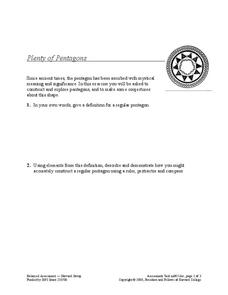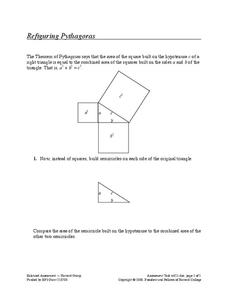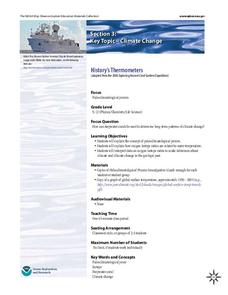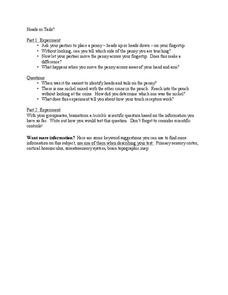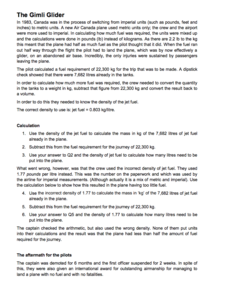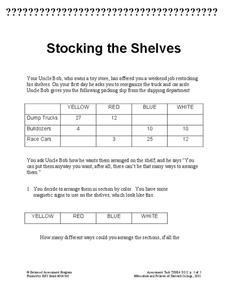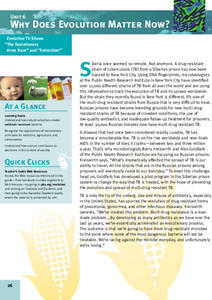Road to Grammar
The Unexplained
Are you afraid of what goes bump in the night? Talk about the supernatural with your English language learners to find out their beliefs while practicing speaking skills. Learners read three different viewpoints on the paranormal...
National Endowment for the Humanities
Albert Sabin and Bioethics: Testing at the Chillicothe Federal Reformatory
Do the ends justify the means? Getting a drug approved in the US is a long and involved process. But at some point out, it involves testing on humans. The ethics of such testing is the focus of a resource that uses Dr. Albert...
Gilder Lehrman Institute of American History
Document Analysis: The Mayflower Compact
Here's a great comprehension worksheet that models for young readers how to focus on short sections of a complicated text and then to create a summary of the entire document based on their understanding of the sections.
K12 Reader
Change the Point of View: First Person and Third Person
How is a story different when told from various points of view? Learn about first and third person points of view with an activity based on Robert Louis Stevenson's Treasure Island. Readers examine a passage written in first person,...
Amazon Web Services
Idiom Dictionary
Examining idioms is a peace of cake when using this graphic organizer! Here, grammarians identify an idiom and use it in a sentence. Then they investigate its literal meaning versus its figurative meaning, and accompany each one with a...
Balanced Assessment
Plenty of Pentagons
Why are only four colors needed to color webs from regular pentagons, not five? An assessment task requires young mathematicians to first construct regular pentagons using a compass and straightedge, then has them consider a shape...
Balanced Assessment
Refiguring Pythagoras
Why was Pythagoras so obsessed with squares? The assessment task posits the question of whether the geometric interpretation of the Pythagorean Theorem holds for figures other than squares. Scholars first consider the case of semicircles...
NOAA
History's Thermometers
How is sea coral like a thermometer? Part three of a six-part series from NOAA describes how oceanographers can use coral growth to estimate water temperature over time. Life science pupils manipulate data to determine the age of corals...
University of Minnesota
Get the Point(s)
Do all areas of your skin have the same sensitivity to touch? Playing with the sense of touch, this experiment has scholars guessing how many pin heads gently touch their arm and hand. In the second part, pupils...
University of Minnesota
Heads or Tails
How exactly does touch help us identify items? Students test this question by feeling a coin without moving their fingers and trying to determine if it is heads or tails. They test their accuracy by rubbing their...
Nosapo
New Year’s Resolution
Begin the new year with a two-part activity that asks class members to formulate a resolution and to write about someone or something they are proud of. These statements are then attached to a snowflake and a mandala which they decorate.
Royal Society of Chemistry
Gimli Glider—Anecdotes for Chemistry Teachers
What's the moral of this story? Units save lives! Teach measurement conversion through storytelling in a quick math-based lesson. Young scientists learn how one country's decision to swap from imperial to metric standard units caused an...
National Nanotechnology Infrastructure Network
Wet Etching in Nanofabrication
Chemistry and physics combine forces to benefit nanofabrications. Learners examine the process of wet etching in nanofabrication. Using corrosive substances such as lemon juice and Coca-Cola, they model the etching process. They then...
Teach It Primary
What Letter Will You Write?
After reading "The Pied Piper of Hamelin," scholars discuss the emotions the events provoked in its characters. In pairs, writers compose a letter depending on the topic and style of their choice then reply to their own or a peer's...
Concord Consortium
Stocking the Shelves
How many ways can you stock a shelf? It's probably more than you think! Young scholars use data in a frequency table to determine how many ways to stock a shelf given a specific constraint for types of groups. They then repeat the task...
Cold Spring Harbor Laboratory
Mendelian Genetics Cannot Fully Explain Human Health and Behavior
The breakthrough of Mendelian genetics solved many puzzles for biologists. Then, scientists decided to apply the theory to human behavior. Learn the story and struggle of finding a genetic explanation for hobbies, interests, and mental...
Thoughtful Learning
Checking the Emotion Thermometer
A hand-drawn thermometer provides a strong visual for how much of an emotion a child is feeling. Scholars color the thermometer's mercury to showcase whether what they are feeling is high or low at a certain moment. Questions allow...
Anti-Defamation League
Women's Suffrage, Racism, and Intersectionality
The Nineteenth Amendment granted women the right to vote—as long as they were white. High schoolers read articles and essays about racism in the suffrage movement and consider how intersectionality played a role in the movement. Scholars...
Curated OER
Then and Now
Students explore population and come to understand how it changes over time. In this census instructional activity, students discover what population is and how it changes as they participate in age-appropriate activities.
Curated OER
Then and Now
Students conduct research and use census data to compare different times and places. In this census instructional activity, students interpret data from charts and graphs, comparing census information from two time periods as well as...
Curated OER
Why Does Evolution Matter Now?
Learners examine how natural selection creates antibiotic-resistant bacteria,
recognize applications of evolutionary principles for medicine, agriculture, and conservation, and discuss how science contributes to decisions in context of...
Curated OER
Legends of Airpower: Aviation-Then, Now and Here
Students examine the advancements made in aviation during and since WWII. They read an interview with Charles McGee, research a plane, build a model of a plane, and develop a Powerpoint presentation about aircraft.
Curated OER
I'm in Business, Now What Do I Charge?
Learners determine what price must be charged in order for an entrepreneur to breakeven and to make a profit. They calculate the breakeven price, identify opportunity costs, and write a paragraph explaining what costs should be used for...
Curated OER
Now This is a Contender, Allow Me to Prove It
Tenth graders persuade others to see their Blank History Month postage stamp as the best choice. In this African-American history lesson plan, 10th graders research noteworthy African-Americans and create postage stamps and write...
Other popular searches
- Then and Now
- Transportation Then and Now
- Families Then and Now
- That Was Then This Is Now
- Medicine Then and Now
- School Then and Now
- Schools Then and Now
- Thanksgiving Then and Now
- America Then and Now
- Now and Then Clothing
- Now and Then Movie
- Communities Then and Now





